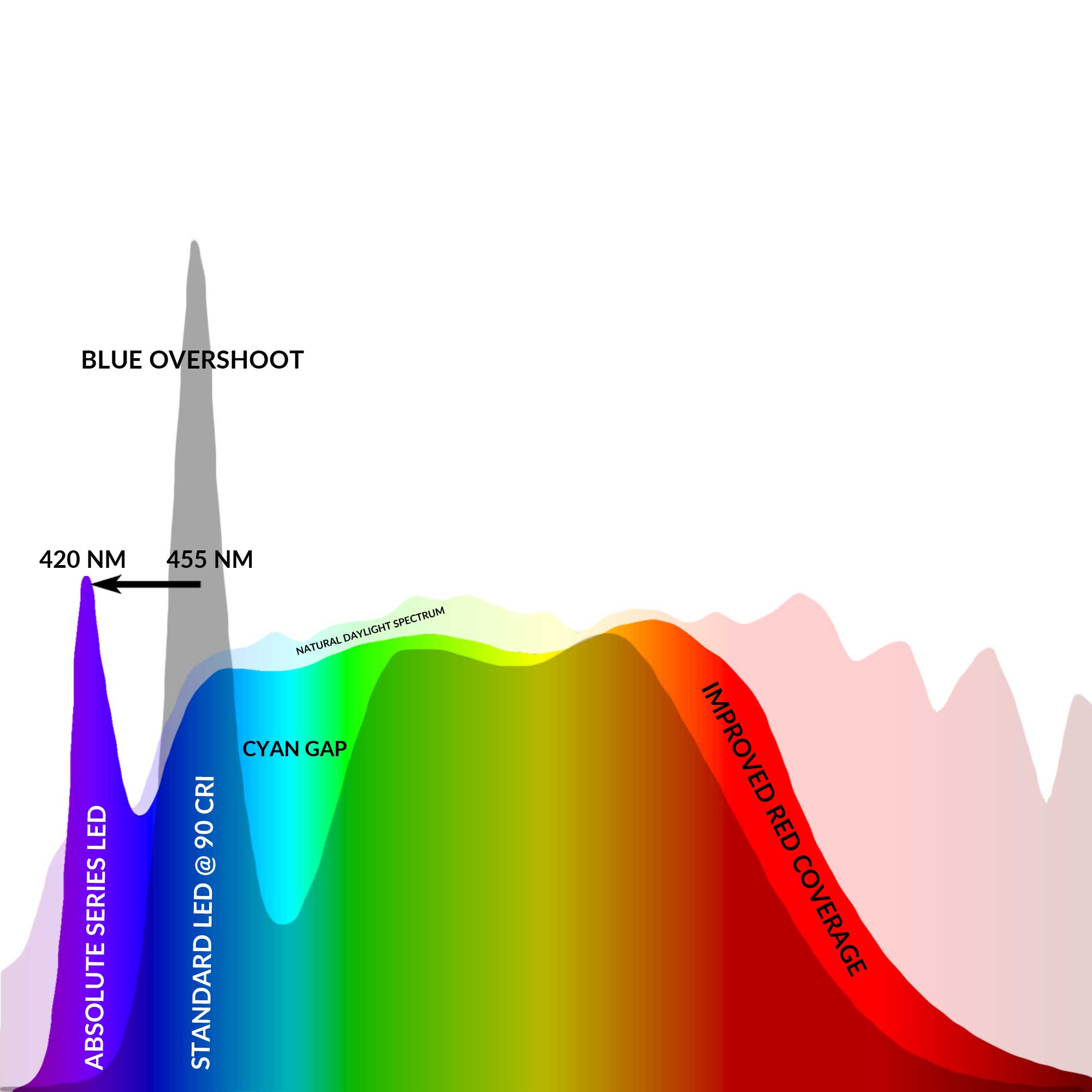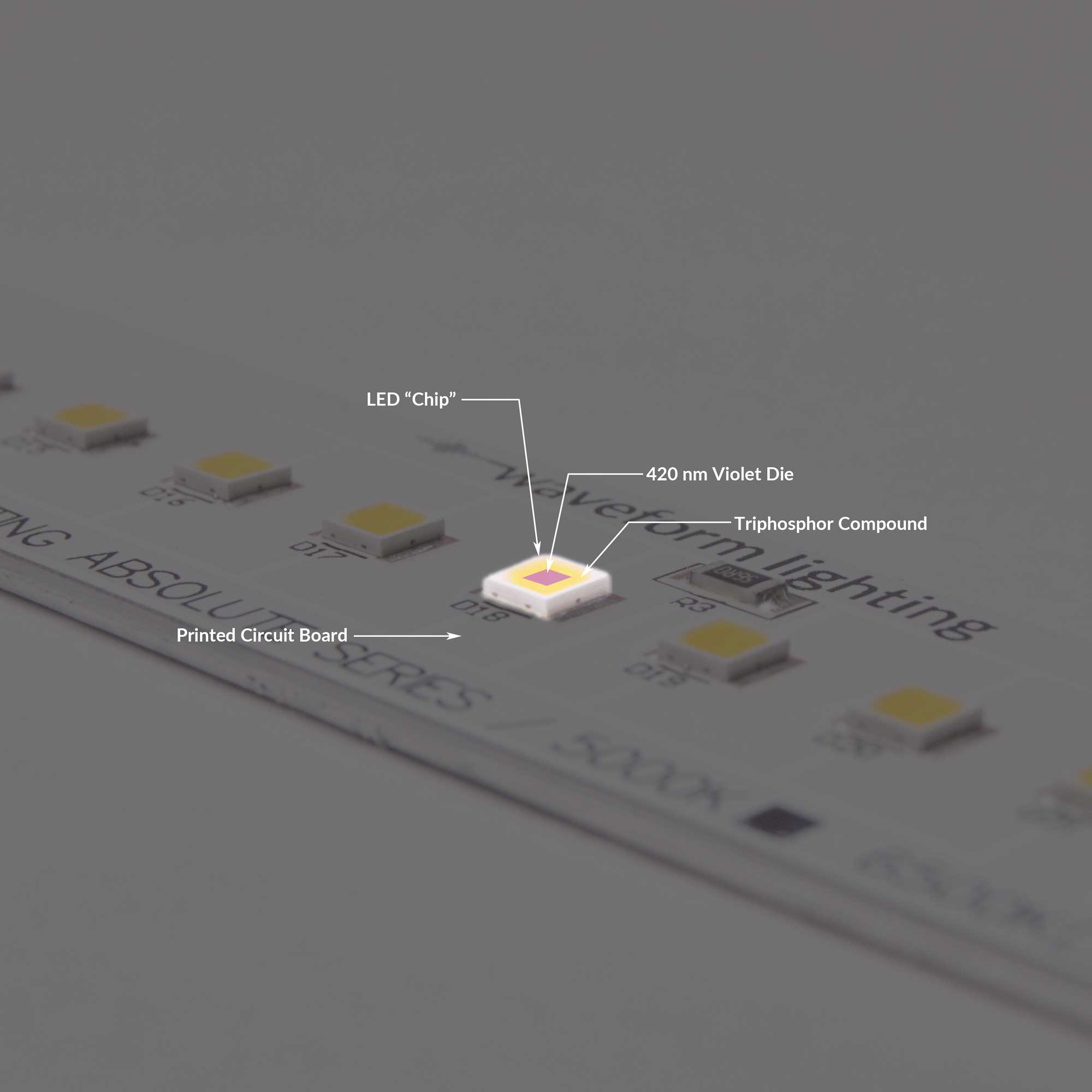
What's Different With ABSOLUTE™?
Traditional white LEDs use 455 nanometer blue die as the underlying light source, and a dual-phosphor mix of green and red phosphors to achieve a semi-full spectrum light output.
This results in what is commonly referred to as the "cyan gap" - where there is a lack of light energy in the region between blue and green wavelengths, and an overshoot of blue wavelength energy. A close look at color rendering scores such as CRI R12 will also reveal that blue colors may appear over or under-saturated.
ABSOLUTE SERIES™ LEDs utilize a different method of producing white light to eliminate the cyan gap and blue overshoot. By shifting the underlying light source wavelength to a violet 420 nm die, a fuller, wider spectrum is made possible. This also provides energy coverage down to the nUV wavelength range.


What's Different With ABSOLUTE™?
Traditional white LEDs use 455 nanometer blue die as the underlying light source, and a dual-phosphor mix of green and red phosphors to achieve a semi-full spectrum light output.
This results in what is commonly referred to as the "cyan gap" - where there is a lack of light energy in the region between blue and green wavelengths, and an overshoot of blue wavelength energy. A close look at color rendering scores such as CRI R12 will also reveal that blue colors may appear over or under-saturated.
Waveform Lighting's ABSOLUTE SERIES™ LEDs utilize a different method of producing white light to eliminate the cyan gap and blue overshoot. By shifting the underlying light source wavelength to a violet 420 nm die, a fuller, wider spectrum is made possible. This also provides energy coverage down to the nUV wavelength range.

Advanced Light Recipes
To address the spectral deficiencies in standard LEDs, ABSOLUTE LEDs rely on a different set of material compositions at different wavelengths.
In order to mitigate the impact of a sharp peak in the blue wavelength region, the peak wavelength of the underlying light source die is shifted to 420 nm. Immediately, this provides the additional benefit of wavelength energy in the violet region.
Then, a triphosphor mix of red, green and blue phosphors are added and mixed into the LED chip using a precise light recipe. By adding a blue phosphor into the mix, light emission in the blue region of the spectrum is much smoother, simultaneously eliminating the blue overshoot as well as cyan gap.
Measuring CRI for ABSOLUTE SERIES™
The Color Rendering Index (CRI) measures the ability of a light source to bring out the true colors of an object. But what's really going on here? It is the spectral qualities of a light source that determine its color rendering abilities. Full spectrum light sources, by virtue of being similar to natural daylight, must have a very high CRI to be considered a true, full spectrum light source.
Waveform Lighting's ABSOLUTE SERIES™ LED lamps have up to 99 CRI (Ra). This means that our lights are virtually indistinguishable from daylight.
More on CRI →Compare our CRI R values to other light sources by clicking the corresponding buttons below.
- Score:
- 25
- 50
- 75
- 100

Improved White Rendering & Fluorescence
Despite their ordinary appearance, many objects we encounter on a daily basis contain materials that exhibit fluorescence.
For example, white industrial products and textiles such as paper and shirts contain optical brightening agents which react to full spectrum light that contains violet wavelengths, such as natural daylight.
Standard LEDs, however, lack sufficient violet wavelength energy to activate optical brighteners. This results in a dull, yellowish white that does not match an object's appearance under natural daylight.
White rendering is not adequately captured in the CRI evaluation method, but is an important consideration in applications where the accurate rendition of objects containing fluorescence is critical.
ABSOLUTE SERIES Products Currently Available
$375.00
ABSOLUTE SERIES™ LED Flexible Strip - 99 CRI - D50 / D65
$159.00
ABSOLUTE SERIES™ LED Linear Module - 99 CRI - 1 ft / 280 mm MCPCB
Want to learn more?
Visit our product support center to learn more about our products. Download spec sheets, test reports and reach out to us with any questions.
